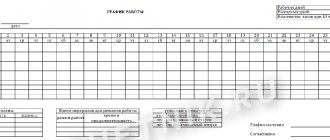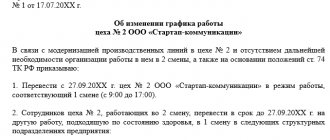Characteristics
An enterprise can establish one of the following types of work schedules according to the Labor Code of the Russian Federation:
- Daily 5-day work with 2 days off.
- Daily six-day work with 1 day off.
- Working week with days off on a rotating schedule.
These regimes are provided for in Article 100 of the Labor Code. In Art. 104 of the Code provides for the possibility of applying summarized time tracking at an enterprise.
Daily types of work schedules are in practice called single-shift.
Article 100. Working hours
The working time regime should provide for the length of the working week (five-day with two days off, six-day with one day off, a working week with days off on a sliding schedule, part-time work), work with irregular working hours for certain categories of workers, the duration of daily work ( shifts), including part-time working days (shifts), start and end times of work, time of breaks in work, number of shifts per day, alternation of working and non-working days, which are established by internal labor regulations in accordance with labor legislation and other regulatory legal acts containing labor law norms, collective agreements, agreements, and for employees whose working hours differ from the general rules established by a given employer - an employment contract.
(as amended by Federal Law No. 90-FZ of June 30, 2006)
Features of the working hours and rest time for transport, communications and other workers with a special nature of work are determined in the manner established by the Government of the Russian Federation.
Summarized accounting
It involves taking into account a longer period than a day or a week. Such a system provides more than just time measurement. Summary accounting is considered a specific form of organizing labor activity. The minimum duration of work is a month, the maximum is a year.
The essence of accounting is that the duration of work during the day for a period on average is equal to the norm. Such a system is provided for enterprises where, due to the specifics of the activity, other types of work schedules (for example, daily or weekly) cannot be established. At the same time, the duration of time for performing professional tasks should not exceed the standard for the accounting period.
Summarized accounting can be weekly, quarterly, annual, monthly. This type of schedule is often used in construction work organized on a rotational basis at transport enterprises.
The maximum duration of a shift with such time accounting is not limited by law. In practice, it ranges from 8 to 12 hours.
In what cases is a work schedule drawn up?
If an organization has adopted a single working time schedule for all employees (a 40-hour work week (five days) with two general days off), such a document does not need to be drawn up.
The need to maintain a working time schedule arises in the following cases:
- irregular working hours (Article 101 of the Labor Code of the Russian Federation);
- working in flexible working hours (Article 102 of the Labor Code of the Russian Federation);
- shift work mode (Article 103 of the Labor Code of the Russian Federation);
- summarized recording of working time (Article 104 of the Labor Code of the Russian Federation);
- dividing the working day into parts (Article 105 of the Labor Code of the Russian Federation).
The work schedule in these cases is drawn up in order to monitor compliance with normal working hours for the entire accounting period (month, quarter and others, but not more than one year). Based on the data for each employee for a certain accounting period, wages are calculated, including taking into account the time of overtime or shortfall.
In order not to waste time drawing up your own schedule form, we recommend that the HR specialist download a blank form - a sample work schedule for the month, prepared by experts (it is attached at the end of the article).
IMPORTANT!
The length of the accounting period should be determined by each organization. It should be borne in mind that it is advisable to set an accounting period as a month if the employee monthly works the number of hours corresponding to the normal working hours, or more hours than provided for by the norm (i.e., overtime hours are initially included). This will allow you to determine the number of overtime hours each month and make appropriate additional payments.
If the employee’s schedule shows that in some months he works more hours, and in others less than the norm, it will be fair that overtime in one month is compensated by underwork in another. In this case, it is advisable to set the duration of the accounting period to more than one month. The number of months in the accounting period should be set so that the sum of working hours according to the accounting document coincides with the standard working time. The number of overtime hours is determined not monthly, but once for the entire accounting period as a whole.
Irregular mode
This system of organizing labor activity provides for the employer’s ability to periodically involve employees in performing duties outside the normal working hours. The list of relevant positions is fixed by a collective agreement or internal regulations of the enterprise.
A feature of this type of work schedule is that the employee is subject to the general schedule established in the organization, but at the request of the manager, he can be delayed to perform duties beyond the shift. A citizen can also be called to the enterprise before the start of his shift.
conclusions
Above, we examined various nuances of the functioning of the company according to different schemes. Before drawing up a work schedule, you should definitely think about what the best option will be for your organization, how many shifts will operate, what is the duration of the shift and rest break. Then check that the chosen mode does not violate legal requirements, if necessary, consult with an experienced lawyer. Then issue an order for the enterprise, enter the data into the internal regulations and then notify the people working for you.
Attention:
employees may refuse to work under the new rules. In this case, you will have to fire them by agreement of the parties. Those who agree to the new conditions sign the relevant documents and are transferred to the new rules.
The schedule is usually filled out by an accountant or a foreman in charge of a team. The hours are entered into the schedule or the day worked is simply closed if classic single-shift work is carried out. At the end of the week or month, the schedules are transferred to the responsible person (accountant), who uses them to calculate the number of hours worked and payroll. If a person worked on holidays or weekends, or had overtime or off-hour work, then the cost of an hour increases (usually twice). Now you know what work schedules there are (a sample of a classic document can be downloaded from this link). Use this information when conducting business, and if necessary, consult with a lawyer.
Important point
It is necessary to take into account that with an irregular schedule, employees can only be involved in the performance of those duties that are specified in the employment contract. This means that the employer cannot oblige the employee to perform other work, including outside the normal working hours.
Article 60 of the Labor Code expressly prohibits requiring an employee to perform duties that are not specified in the contract.
Where an entrepreneur might stumble
Sometimes life is pain. Here we have collected known problems associated with the operating mode in the service sector.
Invalid operating mode
If the exact opening hours are written on the sign, but the entrepreneur opens the outlet later or does not open at all, this is a reason for punishment from Rospotrebnadzor. People get caught doing this, an example is case No. A48-2801/2016.
Operating mode not specified
For the lack of operating hours on the sign, administrative cases are also opened and punished. Example - case No. A53-5149/2011.
Shopping center opening hours
Typically, shopping centers require tenants to comply with internal regulations. Departments with lowered roller shutters repel visitors. Employees' work and lunch hours are included in the lease agreement. For violation, they promise a fine or early departure without refund of the deposit. Whether to agree or not is up to the entrepreneur. This is freedom of contract from Art. 421 Civil Code of the Russian Federation.
If the tenant has signed an agreement with such a condition, he will have to work according to the shopping center regime. And also - to take the rap in front of the administration for the tardiness of their employees.
But if the department was closed because the lights were turned off, the entrepreneur is not to blame. Shopping center fines can be repelled; here is an example - case No. A45-25402/2014.
Simple online accounting for entrepreneurs
The service will replace your accountant and help you save money. Elba will prepare the reports herself and send them via the Internet. It will calculate taxes, help prepare documents for transactions and will not require special knowledge.
Try 30 days free Gift for new entrepreneurs The promotion is valid for individual entrepreneurs under 3 months old
Operating mode of a non-stationary retail facility
Street outlets, for example, face painting services in the summer, are also required to work on schedule. In addition, there are requirements from the local administration.
It is beneficial for the city that space on the street does not remain idle. The contract for placing a point often stipulates a rather large fine for intermittent operation. Therefore, the entrepreneur will have to adhere to the schedule from the agreement with the local administration.
However, we found an interesting legal dispute. The owner of an ice cream cart proved that he doesn't have to stand outside in strong winds. The cart is carried away, it is unsafe. The entrepreneur will not pay a fine of 280,000 rubles to the city - case No. A40-299203/18-41-2232.
Job categories
As mentioned above, not all employees can be subject to an irregular work schedule. Types of positions may be provided not only in a collective agreement or work rules, but also in industry, regional and other regulatory documents.
An irregular schedule may apply to persons:
- Technical, administrative, economic, management personnel.
- The labor activity of which cannot be taken into account in time.
- Distributing their working time at their own discretion.
- The schedule of which is divided into parts of indefinite duration.
Night duty of employees
With a certain schedule, employees are forced to work not only during the day, but also in the dark, which is usually called night mode - the period between 10 pm and 6 am is special, since at this time the body must rest and not cope with work responsibilities.
Night work is also regulated by the Code
Employees are subject to certain conditions that apply to them if they work at night:
- At night a person has the right to work 1 hour less.
- A night shift becomes equivalent to a day shift if the performance of work duties at night is necessary for the functioning of the enterprise, as well as with a shift schedule and a six-day work week.
- Pregnant women and minors cannot go to work at night (with the exception of the creative and entertainment industries).
- Some categories of employees can go to work at night if they have written consent with them. Such employees include the category of women raising a child 0-3 years old, persons with disabilities who will not be harmed by night work. In addition, employees who are parents of disabled children, caring for sick relatives, single mothers and single fathers with a child under five years old can submit a request for night duty on their own initiative. The application will need to be accompanied by a doctor’s opinion stating that the potential employee has no contraindications for staying awake at night. This is especially true for disabled people who are registered with doctors - they are required to hand over to the employer all documents from which one can clearly judge their current health status.
- The work of creative teams and mass media teams is regulated by agreement within the team, while the need to work at night is approved by a special procedure - passing a triple commission.
In order to start working at night, you need to notify management of your desire.
The consent to work at night usually states:
- Information about the manager/management team.
- Information about the employee.
- Actually agree with the night operating mode.
- They put a date and signature.
Next, the application goes to the manager and is reviewed by him personally, or by employees of the HR department, he forms the appropriate order.
Not everyone has the right to work at night
The Labor Code does not allow working more than 7-8 hours - this is the standard working time at night. Specifically, the formation of the night shift range occurs in accordance with working conditions and basic benefits associated with work activity.
As part of the work schedule, an employee may be partially affected by night shifts - for example, if he works in the evening and leaves work at one in the morning. In this case we are talking about the so-called partial night time.
If an employee was on shift in the evening and turned it in at 4 am, then the employee who replaced him will no longer be assigned night duty. A night shift is considered when at least half of the time was spent in the dark.
The shift preceding the night work period is called the evening shift. For an hour of work at night, the premium will be 20%.
Night work is an additional burden on the body
In general, the duration of night working hours is contained in local documents, collective and individual acts and agreements. You can find the following elements in them:
- The beginning and end of the night working period, as well as the duration of the working day that follows the night shift.
- Payment for night time.
- Responsibilities that must be performed when working at night.
A reduction in the night work period is not implied for those citizens who meet the following categories:
- Having a reduced schedule during the day.
- Initially hired as part of the night regime - watchman, security guard, etc.
For all other employees who, due to their duties, do not have to go to work at night, the Code prescribes a certain number of night shifts - they are prohibited from visiting the workplace at night for more than 2 days in a row.
Night wage units are higher than day ones
How are night shifts paid?
Staying at the workplace at night is subject to additional monetary payments. Government surcharges in the form of various coefficients have floating values. The Labor Code also does not specifically indicate the amount of the premium. Partial recommendations for payment for night work can be found in the table.
Table 3. Night work - how it is encouraged
| Field/specialties | Promotion | Appointed by whom/what |
| 1. Military. 2. Fire department employees. 3. Watchmen, security guards. | 35% of payment for a daily unit of labor | Decree of the State Customs Committee of the USSR of 1990 |
| Medical workers | 50% of payment for a daily unit of labor | By order of the Ministry of Education - 1999 |
| 1. GUFSIN employees. 2. Employees of internal affairs bodies. | 35% of payment for a daily unit of labor | By order of the Ministry of Justice in 2000 |
Some employees are entitled to benefits for night work
In general, by studying statistical and reporting data in the business environment, we can conclude that each unit of labor will be paid more for working at night, with the additional amount ranging from twenty to forty percent. At the level of the Government of the Russian Federation, a minimum bonus for such work has been approved in the amount of 20 percent.
Duties of the parties
It must be said that when applying the provisions of Article 101 of the Labor Code, the employer does not have to obtain consent from either the employee or the trade union to engage in work beyond the standard duration. This right is initially stipulated in the employment contract.
The employee, in turn, cannot refuse to perform his duties on an irregular schedule. Otherwise, his actions will be regarded as a gross disciplinary offense.
The establishment of an irregular regime, however, does not mean that employees will not be subject to the provisions of the Labor Code on norms of rest and work time. In this regard, their involvement in work activities beyond the shift duration determined for them can only be carried out sporadically.
Preliminary actions
In addition to the main functional responsibilities, the working period includes questions of the preparatory plan:
- checking constituent documentation and other papers;
- putting things in order in the workplace;
- reporting and delivery of manufactured products.
Other preparatory work time is included in the work schedule. For example, a medical examination of the driver before leaving for the route. Activities such as walking from home to work, changing clothes, and taking a lunch break are not included in working hours.
The schedule is developed taking into account other part-time and reduced modes and volumes of work. The inclusion of such species is carried out by issuing an order. Information about the time worked is reflected in the exit report card.
When determining work intervals, the main point is compliance with the law and the correct execution of regulations. Establishing a normal working period affects productivity, preserves ability to work, and prevents fatigue, which leads to mistakes and affects health.
Additional leave
Due to the fact that with an irregular schedule, certain overtime occurs in excess of the standard length of the day, the Labor Code, as some compensation, establishes the possibility of employees receiving additional leave. Its duration is determined in the collective agreement or rules of procedure. Leave is paid and provided annually.
If such a vacation period was not provided, with the written consent of the employee, overtime is counted as overtime.
The conditions and rules for providing paid additional leave for employees of organizations financed by federal, regional, and local budgets are established by the Government, authorities of constituent entities or territorial self-government, respectively.
Sliding work schedule
This type of work mode was introduced in the 1980s. At first it was applied to women with dependent young children. Over time, this system spread to other workers.
Flexible mode is a type of work schedule in which individual employees or teams of departments are allowed to independently regulate the start, end and total duration of the shift. In this case, it is necessary to fully work out the total number of hours established by law for a specific accounting period.
The key feature of the flexible mode is that this type of work schedule is established by the employer and employee by agreement not only when hiring, but also in the process of carrying out activities. However, it can be set for a specific period or determined without specifying a period. The agreement reached between the parties is confirmed by an order.
Types of charts
There are several types of charts. The most popular are:
- Weekly schedule.
- Flexitime.
- Shift work.
A weekly schedule is effective when employees can work standard hours at any time and in any quantity, without violating hourly standards.
Example:
AiCoda company develops software. Each employee must work 40 hours a week, but the company has adopted a weekly work schedule. Employees work on a free or flexible schedule: some come at 9 and leave at 21, others at 12 and leave at 17, but in general they are required to work 40 standard hours at a time that is convenient for them (or when the office is functioning).
The sliding mode is usually used where employees have to travel frequently on business trips or there is simply no way to determine when the working day began and when it ended, that is, the work is recorded in fact. Shift mode is used where work is carried out in 2–3 shifts. Thus, according to Article 103 of the Labor Code, it can be used under the following conditions:
- Inability to stop the production process (stopping would result in equipment failure or damage to raw materials/finished products), while the process itself lasts longer than a standard 8-hour working day.
- Stopping equipment can lead to serious losses.
- Activities cannot be stopped so that people can get the help they need or buy goods. For example, this could be a 24-hour pharmacy or store.
Article 17 of the Labor Code talks in detail about work schedules and modes. In TC you can find the following work schedules:
- A classic normalized day lasting 8 hours.
- An irregular day that can last more than 8 hours (but can also be less than 8 hours).
- Work shifts (first, second, third).
- Calculation of hours worked (or hourly wages).
- Dividing the day into several parts.
When developing a schedule, make sure that it does not violate the law
But no matter what schedule you choose and implement, you need to ensure that employees do not overwork. If it is present, then you must pay employees for extra hours and give them additional time to rest, otherwise this will be interpreted as a violation of the labor code.
Attention:
The Labor Code provides for mandatory rest during the shift, the duration of which can last from 30 to 120 minutes. The classic work week consists of 40 hours.
Features of application
Flexible mode is used when other types of work schedules are inappropriate or ineffective due to various reasons (domestic, social, etc.). Often it allows for more coordinated team activities.
At the same time, the use of a flexible mode is impractical in continuous production and shift work schedules (their types can be installed in both discontinuous and continuous production) if there are no free places at the shift junctions.
The flexible mode can be used for both a five- and six-day week, as well as for other modes. At the same time, the conditions for rationing and payment of wages do not change. The conditions for providing benefits, accrual of length of service, and other rights are also preserved. It must be said that the registration of work books is carried out without mentioning the mode of labor activity.
Opening hours on weekends
There are not many holidays in the Russian Federation during which workers stay at home and rest. They are associated with the New Year holidays, men's and women's international holidays, May holidays and days of unity and independence. Weekends can be either Saturday and Sunday, or one Sunday with a six-day work week. Locally, Monday may also be designated as a day off. There is no clear regulation that an employee has two days off in a row, but such a recommendation can be traced at the legislative level.
The legislation of the Russian Federation establishes the format of holidays and weekends
Working on holidays and weekends means violating the procedure established by the legislation of the Russian Federation. But here there are exceptions to the rule:
- Emergency prevention, industrial accidents and/or liquidation of consequences.
- Under martial law.
- Prevention of property damage in an organization or at the state level, as well as in the event of the risk and occurrence of accidents.
Work on weekends is paid at least 2 times higher than the regular tariff rates within the shift. In other words, piecework workers will receive double payment for the order, hourly employees will receive double payment for the period worked, and for salaried persons a remuneration is expected in an amount equivalent to the payment of one working day.
Instead of money, you can use the benefit differently and ask for future compensation for work on well-deserved days of rest in the form of additional vacation periods. In this case, payment for time off will not be made.
The above standards do not apply to certain areas related to entertainment and spectacle - representatives of creative professions, including workers in cinema, circus shows, drama and opera houses, receive payment in accordance with local acts signed within the team.
Components of a flexible schedule
To use this mode you must install:
- Periods at the beginning and end of the day within which an employee can begin and end work at his own discretion.
- A fixed period during which an employee must be at work. In terms of its duration and significance, this part of the day is considered the main one.
A fixed period allows for the normal flow of the production process and service interactions. In this case, as a rule, the enterprise sets a break for food and rest. He usually divides his working time into 2 approximately equal parts.
The specific duration of flexible schedule elements is determined by the enterprise.
Breaks during working hours
Of the breaks accepted in the organization, the following categories can be distinguished:
- Pauses for eating and rest from work duties.
- Pauses for feeding infants.
Work breaks are subject to clear systematization and payment
If the child has not reached the age of 1.5 years, feeding the child is allowed at least once every 3 hours. The break is at least half an hour. Such breaks are included in working hours and are subject to recording and subsequent payment. The employee herself has the right to add the indicated periods to the lunch period, transfer them in total to the end or beginning of the working day, varying the regime at her own request.
A manager has no right to deny a woman the right to breastfeed, just as she has no right to refuse employees to go to lunch and spend their breaks completely with personal matters. In the case when management insists on working during lunch, in fact we are talking about free labor, since this time is not included in the tariff schedule.
If such cases with bans on breaks are observed in the organization, you must immediately contact the labor inspectorate with a statement. If the outcome is positive, the employer will face not only a court hearing and payment of a fine, but also compensation in the form of double salary in favor of each representative of the work team.
Working hours
The types of sliding work schedules vary depending on the established accounting period in the organization, the time characteristics of the elements of the regime, and the conditions of their use in a particular department.
The maximum permissible length of the day (with a 40-hour week) does not exceed 10 hours. In some cases it can be within 12 hours.
Length of working week
The work week of an organization's employees can have different lengths. This is influenced by the type of working hours preferred by management.
The following types of working time are distinguished:
- normal working hours;
- reduced working hours;
- part-time work.
The normal duration of the labor process implies that employed people work no more than 40 hours per week. And this happens in working conditions that do not require special protection measures.
With a reduced duration of work, the length of the labor process will be less than the norm prescribed in legislative acts. However, employees will be paid as standard in full (not counting teenagers, who are paid depending on the time worked).
A reduced schedule is provided for the following workers:
- citizens under 18 years of age;
- persons whose ability to work is limited (disabled people of groups I and II);
- persons whose work is hazardous or harmful to health;
- educational workers;
- medical staff.
Table: length of reduced working hours for a certain group of people
| Category of workers | Duration of work |
| Minors | The working hours of minors who are not students, as well as those who are students but work during the holidays, are established:
The length of working time for students of educational institutions under the age of 18 working during the academic year in their free time from study cannot exceed half of the working time standards:
The work of minors is paid in proportion to the time worked or depending on output. |
| Persons with reduced ability to work | The working hours for disabled people of groups I and II are no more than 35 hours per week with full pay. |
| Workers engaged in work with harmful and (or) dangerous working conditions | Their working hours are no more than 36 hours per week. |
| Teachers | Work no more than 36 hours a week |
| Medical staff | Their work does not exceed 39 hours a week. |
| Students in part-time and part-time forms of education | For a period of ten academic months before the start of a diploma project (work) or passing state exams, a working week shortened by 7 hours is established at their request. During the period of release from work, these employees are paid 50% of the average earnings at their main place of work, but not less than the minimum wage. |
Labor time can be reduced in the following ways:
- by providing the employee with one day off from work per week;
- by reducing the working hours during the week.
Part-time working time is considered to be work time the length of which is less than the norm.
Prerequisites
To apply a flexible mode, the enterprise must have a clear system for recording the time worked by employees and their completion of production tasks. In addition, control over the most complete and rational use of time by each employee in both fixed and flexible periods must be ensured.
It should be noted that the use of this regime is regulated by several regulations. For example, the Order of the Ministry of Communications approved a list of employees for whom a flexible schedule may be provided.
Shift mode
It involves working in 2, 3, 4 shifts during the day. For example, an enterprise may have three 8-hour shifts. In this case, employees perform production tasks in different shifts over a certain period of time (a month, for example).
Such a schedule is introduced at the enterprise if the duration of the production cycle exceeds the norm for the duration of daily work. The purpose of the shift mode is to increase the efficiency of use of equipment, the volume of products and services.
When using such a schedule, each team of workers must complete production tasks during the established shift duration. For example, staff work 8 hours in a five-day week. The schedule determines the order in which an employee moves from one shift to the next. It can either be drawn up as a separate local document or act as an annex to the main agreement.
The shift schedule must reflect the requirements of Article 110 of the Labor Code on providing staff with continuous weekly rest of at least 42 hours. Inter-shift (daily rest) must be no less than double the working time in the shift preceding the rest. The law does not allow working two shifts in a row.
Employees must be familiar with the schedules for 1 month. before their implementation. Failure to comply with this requirement is regarded as a violation of the right of workers to timely information about changes in their working conditions.
The shift schedule can be day, night, or evening. A shift in which at least 50% of the time is spent at night is considered a night shift.
Main types and their features
Single shift schedule
The majority of working citizens work on a regular or single-shift schedule. This is the most common operating mode.
Recording of time worked for such a schedule can be done by day, week, or on a cumulative basis for a certain period (for example, three months for hazardous work). If records are kept by day, any work activity that goes beyond the established norm will be considered overtime work (based on Article 99 of the Labor Code).
The employer may set the following number of working days:
- five in one week;
- six in one week;
- or establish a sliding regime for providing rest (according to a schedule);
- introduce a summary record of hours worked (for example, this is convenient when working part-time).
The minimum duration of the accounting period, if it was established at the enterprise, is one month, and the maximum is one year.
When recording hours in this way, the employer must ensure that the daily norm does not differ very much from standard employment (for example, if at an enterprise one day is equal to 7 hours of work, the schedule drawn up according to the summary accounting tends to the same figure).
The total calculation is relevant for those types of work where it is difficult to comply with the general established norm.
For example, when working on vehicles (drivers transport goods only at certain hours, the rest of the time they are free). At enterprises operating continuously, a shift with total time taken into account cannot exceed 8-12 hours. With this schedule, remuneration is calculated according to hours worked.
Irregular schedule
An irregular schedule means work activity that goes beyond the standard schedule adopted by the enterprise.
Typically, the employer involves only certain categories of employees or individual employees in such activities. Labor is episodic (temporary) in nature. At the same time, the list of persons who can be involved in overtime work is clearly displayed in one of the local documents (for example, in a collective agreement or in internal regulations).
The principle of such work activity is that the employee stays at the workplace at the request of the employer and carries out the production task assigned to him. In some cases, employees are called before the start of their shift or working day.
According to Article 60 of the Labor Code, employers are prohibited from requiring an employee to perform duties not specified in the employment contract!
It is also unacceptable to assign work that differs in nature from the main profession or qualification (for example, an accountant cannot clean the workshop).
It should be taken into account that the list of workers involved in overtime work may be provided for by industry or departmental, as well as regional regulations.
Mainly:
- technical, managerial and administrative personnel;
- persons working at their own discretion (distributing working time themselves); persons employed on a fragmented work schedule.
The employer must understand that any overtime work is assigned to the employee
only with his written consent. An employee can be forced to be called only in emergency situations, for example, to eliminate the consequences of a man-made accident.
According to Article 119 of the Labor Code, such work is compensated by the employer: the employee can receive additional payment at a double rate or take out an additional paid vacation period.
Flexible work schedule
It is established only for certain categories of employees (for example, pregnant or pregnant employees, persons caring for disabled people, and so on).
Such a schedule is established through the signing of an additional agreement, which can be either urgent or indefinite..
Based on the agreement, management issues an order allowing the standard schedule to be changed for a specific employee.
Flexible work is not acceptable in continuously operating businesses. Also, it is not established in conditions of three-shift work. If two shifts are established, but there are no free places at the junctions of these shifts, it is also not possible to establish such a schedule.
The work schedule can be:
- completely flexible, when the employee chooses the time of coming to the workplace and leaving home (within one shift or day!);
- fixed, when an additional agreement establishes the hours of leaving and leaving work.
More often, such schedules are established with single-shift work five or six days a week. At the same time, the terms of remuneration, accrual of length of service and provision of benefits do not change, since such a schedule is determined by special household or social conditions (provided to students, pregnant women, young mothers).
Shift work
Shift work or a shift schedule is also a fairly common labor practice that allows for the continuous operation of a legal entity. Moreover, each of the employees manages to work in different shifts during the accounting period, for example, a month or a week. Working two shifts in a row is not allowed! (Article 103 of the Labor Code)
When establishing such a regime, the employer is guided by the opinion of the trade union organization - it is necessary to obtain its consent. And according to Article 110 of the Labor Code, workers engaged in shift work must rest at least 42 hours weekly.
For work on night shifts, an additional payment to the basic salary is established (its amounts are fixed in the collective and labor agreement).
Shift method
This is a special form of organizing work activities outside the place of residence of personnel. The rotation method is used if, due to the nature of their work, employees cannot return home every day.
This mode is used to reduce the construction, reconstruction, and repair time of social and industrial facilities in uninhabited, remote areas, and in regions with special climatic conditions.
The specificity of the rotational method is that the personnel are accommodated in rotational camps - complexes of structures and buildings used to ensure the recreation and vital functions of personnel.
Mandatory medical examination
Based on Art. 213 of the Labor Code of the Russian Federation, medical examinations are of two types:
- In order to confirm professional suitability for a specific work activity, the absence of occupational diseases and timely identification of symptoms: in harmful and dangerous types of work, as well as those related to the transport of passengers and cargo.
- To prevent the spread of diseases.
These two types can be combined.
Timely medical examinations are especially important for citizens who work:
- in the food industry and trade, catering establishments;
- at waterworks;
- in medical and children's institutions.
Medical examinations are carried out at the expense of the company, which is obliged to compensate for personal funds spent.
Duration of work on a rotational basis
A shift is a general period that includes the time of work and inter-shift rest in the village. The shift can be 12 hours daily. In general, the duration of the shift cannot be more than 1 month. However, by agreement with the trade union, it can be increased to three months.
With the shift method, a summary record of time is kept for a month, quarter, or a longer period, but not more than for a year. The accounting period covers all time of work, travel to the location of the enterprise and back, and rest. The total working time should not exceed the normal number of hours provided for in the Labor Code.
Fragmented day
The division of the day into parts is regulated by Article 105 of the Labor Code. As a rule, a fragmented schedule is introduced at enterprises engaged in serving the population, passenger transport, communications, and in trade organizations.
The division of the working day is carried out by the employer in accordance with local regulations adopted taking into account the opinion of the trade union.
The law does not establish the number of parts into which a day can be divided. As a rule, it is divided into 2 equal periods with a two-hour break. It is not paid. It is also possible to establish a greater number of breaks.
For time worked under a split schedule, employees receive additional pay.








